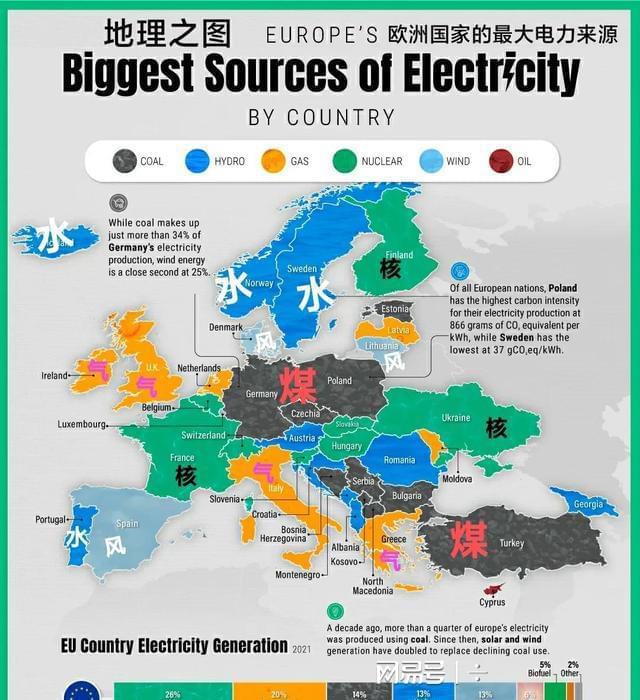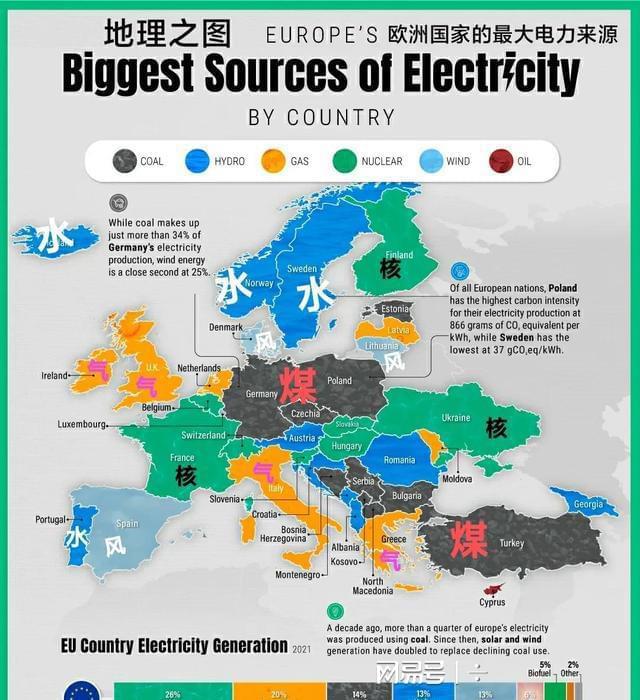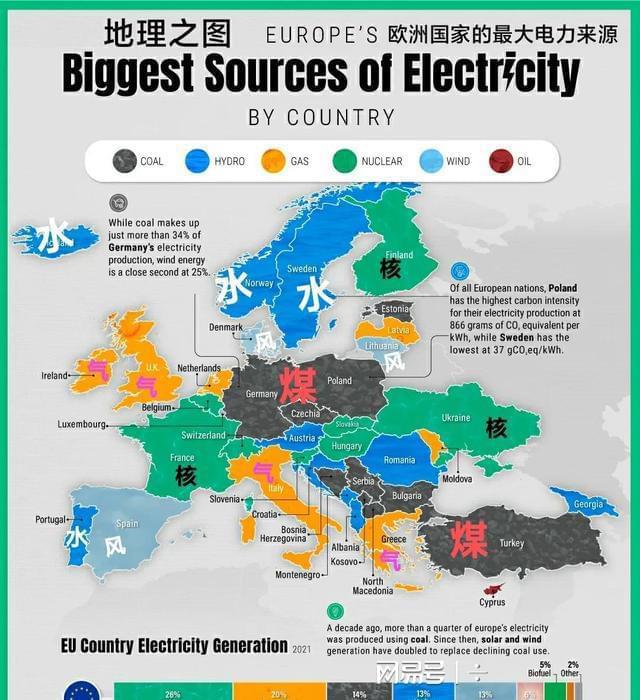Evaluate the largest power generation source in European countries, with huge contributions from power transformers
Writer: Hengfeng you electric Time:2023-04-23 views:times
This picture shows the largest power sources in Europe, including hydropower in Norway, wind power in Denmark, nuclear power in France, natural gas power in the UK, and coal power in Germany. Which one do you think is the best?
Hengfengyou Electric Engineer EVAN believes that although different power sources play an important role in the daily development of society, the effective transformation of these power sources cannot be separated from the effective operation of various types of power equipment, in which the role of power transformers is particularly important.
A transformer is a device that uses the principle of electromagnetic induction to change the AC voltage. The main components are the primary coil, the secondary coil, and the iron core (magnetic core). Main functions include: voltage conversion, current conversion, impedance conversion, isolation, voltage stabilization (magnetic saturation transformer), etc.
According to the purpose, it can be divided into:
power distribution transformers and
special transformers, specifically including
electric furnace transformers,
rectifier transformers,
power frequency test transformers, voltage regulators,
mining transformers,
audio transformers,
intermediate frequency transformers,
high-frequency transformers, impact transformers, instrument transformers, electronic transformers, reactors, mutual inductors, etc.
Transformer is the basic equipment for power transmission and distribution, and its components include the body (iron core, winding, insulation, and lead wire), transformer oil, oil tank, and cooling device, voltage regulating device, protective device (moisture absorber, safety airway, gas relay, oil conservator, and temperature measuring device), and outlet bushing. Widely used in industries, agriculture, transportation, urban communities, and other fields

Norway is not only rich in oil and natural gas resources, but also rich in hydropower resources. In addition to Norway's small population and large land, hydropower resources not only generate enough electricity for the entire population, but also use the surplus electricity to develop the high-energy electrolytic aluminum industry.

Even so, Norway's electricity is often surplus, and surplus electricity will be exported to neighboring countries such as Sweden and Denmark.
Wind power in Denmark
Denmark is known as the "Kingdom of Wind Power". The largest source of power generation in Denmark is wind energy, but wind energy is unstable, sometimes more and sometimes less. How does Denmark solve this problem?

The Danish solution is to combine wind energy with part of Norway's hydropower generation, which perfectly solves the problem of wind energy instability. When there is less wind, there will be more hydropower generation. When there is more wind, hydropower stations will be required to generate less electricity and store more water. The important distribution equipment for wind power generation is the wind power step-up transformer.
Nuclear Power in France
Nuclear power generation is the largest source of electricity in France, generating 379.5 TWh (379.5 billion kWh), accounting for 70.6% of the total national output of 537.7 TWh, the highest percentage in the world.

Most nuclear power plants in France are located far from the coast and obtain cooling water from rivers. These plants use cooling towers to reduce their impact on the environment. The temperature of the discharged water carrying waste heat is strictly restricted by the French government, which has proven problematic in the recent heat wave.
France is one of the few countries in the world that has an existing nuclear fuel reprocessing project. The United States and Japan also hope to develop a more closed fuel cycle similar to that achieved by France.
Natural gas power generation in the UK
Countries such as the United Kingdom, the Netherlands, and Ireland all rely mainly on natural gas for power generation. The United Kingdom relies on natural gas fields in the North Sea, and there is no shortage of natural gas. Therefore, it is relatively normal to rely mainly on natural gas for power generation.
In 2020, 55% of the UK's electricity grid supply came from low-carbon electricity (including 24.8% from wind energy, 17.2% from nuclear power, 4.4% from solar energy, 1.6% from hydropower, and 6.5% from biomass), 36.1% from fossil fuel electricity (almost all from natural gas), and 8.4% from imports.

In 2004 and 2008, the UK generated 160 TWh and 177 TWh of natural gas power, respectively. In both years, the UK was the fourth largest natural gas power generation country.
In 2005, the UK produced 3.2% of the world's total natural gas, ranking fifth in the world.
After 2009, the amount of natural gas produced in the UK began to decrease, and natural gas also needed to be imported. The main source of import was naturally Norway, next door.
After 2016, due to the decline in natural gas prices and the tight economy of coal-fired power plants, three coal-fired power plants were closed in the UK that year. With a large amount of natural gas as the main source of power generation, coal-fired power generation with higher pollution has gradually been phased out.
Coal Electricity in Germany
Germany is a traditional coal producing country, especially lignite. Its lignite reserves are very large. After many lignite mines are mined, Germany directly builds power plants next to the coal mines, which is very simple and rough.

With the progress of technology and the requirements of environmental protection, there are fewer and fewer coal-fired power plants in Germany, while wind and solar power generation are increasing. In the future, Germany will gradually phase out coal-fired power plants and replace them with renewable energy for power generation.
In the four links of power generation, transmission, distribution, and consumption, power transformers appear in the first three links.
First, in the power generation phase, power transformers transmit the electrical energy generated by the power plant to the grid, and increase the voltage output by the power plant to meet the requirements of the rated high voltage of the transmission grid. The transformer used here belongs to a step-up transformer.
Second, it is used for voltage conversion between power grids of different voltage levels.
Third, it is used at the end of power transmission to reduce the voltage through power transformers at all levels to meet the voltage requirements of the distribution network.
Power transformers have played a significant role in the effective use of power resources in various countries.
Due to the Russian-Uzbekistan War, the global demand for new energy is increasing, and the demand orders for supporting photovoltaic transformers, wind power step-up transformers, energy storage and other new energy transmission and distribution are also increasing.
Hengfengyou Electric Group is an export-oriented enterprise specializing in power transmission and distribution products, integrating product research, development, manufacturing, and trade. It is a designated supplier for Fortune 500 companies and has long provided high-quality products for various types of power industries such as hydropower, wind power, and coal power. The main products are power transformers, medium and
low voltage switchgear,
distribution boards, circuit breakers, transmission towers, wires and cables, and other power transmission and distribution equipment









